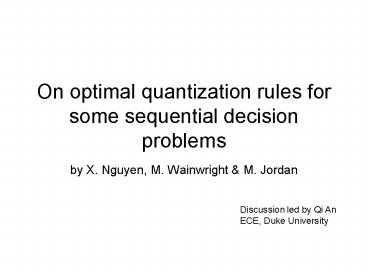On optimal quantization rules for some sequential decision problems - PowerPoint PPT Presentation
1 / 16
Title:
On optimal quantization rules for some sequential decision problems
Description:
On optimal quantization rules for some sequential decision problems ... Usually, O{1,...,M} and U{1,...,K}, where M K. quantization functions. decision rule ... – PowerPoint PPT presentation
Number of Views:108
Avg rating:3.0/5.0
Title: On optimal quantization rules for some sequential decision problems
1
On optimal quantization rules for some sequential
decision problems
- by X. Nguyen, M. Wainwright M. Jordan
Discussion led by Qi An ECE, Duke University
2
Outline
- Introduction
- Background
- Approximate design
- Suboptimality of stationary designs
- Discussion
3
Introduction
- Whats decentralized detection problem?
- A hypothesis problem in which the decision maker
have no direct access to the raw data, but
instead must infer based only on a set of local
quantization functions and a sequence of summary
statistics. - Whats the goal?
- The goal is to design both the local quantization
functions and to specify a global decision rules
so as to predict the underlying hypothesis H in a
manner that optimally trades off accuracy and
delay
4
Introduction
- For general framework of sequential decentralized
problems, Veeravalli defined five problems (case
A to E) distinguished by amount of information
available to the local sensors. - Veeravalli use likelihood ratio test to solve the
case E, where each local sensor has its current
data, On, as well as the summary statistics form
all of the other local sensor.
5
In Veeravallis paper, he conjectured that
stationary local decision functions may actually
be optimal for case A, where neither local memory
nor feedback are assumed to be available.
In this paper, the author shows that stationary
decision functions are, in fact, not optimal for
decentralized problem of case A.
O1n
Otn
Usually, O?1,,M and U?1,,K, where MgtgtK
S1
St
U1nfn(O1n)
Utnfn(Otn)
quantization functions
S0
fusion center
H?n(U11,,Ut1,U12,,Ut2,,U1n,,Utn)
decision rule
Let XnO1n,,Otn and ZnU1n,,Utn .
6
Sequential detection
- Consider a general centralized sequential
detection problem. Let P0 and P1 represent the
class-conditional distributions of Z, when
conditioned on H0 and H1, and and
are corresponding density functions. - Focusing the Bayesian formulation, we let
and denote the
prior probabilities of the two hypothesis - The cost function we want to minimize is a
weighted sum
stopping time
cost per step
We want to choose the pair so as to
minimized the expected loss
7
Dynamic programming
- The previous centralized sequential detection can
be solved by DP approach by iteratively updating
the cost function over horizon. - But it is not straightforward to apply DP
approach to decentralized versions of sequential
detection.
8
Walds approximation
The optimal stopping rule for the cost function
takes the form
The optimal decision rule has the form
Lets define two types of errors
9
Walds approximation
The cost function of the decision
rule based on envelop a and b can be written as
where
and
It is hard to calculate this cost function but it
can be easily approximated.
The errors a,ß are related to a and b by the
classical inequalities
10
Walds approximation
If we ignore the overshoot and replace the
inequalities with the equalities, i.e.
we can therefore get the approximate cost
function
where
11
Approximate design
- Now consider the decentralized setting. Given a
fixed stationary quantizer f, Walds
approximation suggests the following strategy - For a given set of admissible errors a and ß,
first assign the values of thresholds
and - Then use the quantity G(a,ß) as an approximation
to the true cost J(a,b).
By assuming
, the author proves
12
Suboptimallity of the stationary design
- It was shown by Tsitsiklis that optimal
quantizers fn take the form of threshold rules
based on the likelihood ratio - Veeravalli asked whether these rules can be taken
to be stationary, a problem that has remained
open.
13
Suboptimallity of the stationary design
- A simple counterexample to show the optimal
quantizer is not stationary
Consider a problem in which and
the conditional distributions are
Suppose the prior are and
, and the cost for each step is
If we restrict to binary quantizers, then there
are only three possible quantizers
1. Design A .
As a result, the pdf for Zn is
2. Design B .
As a result, the pdf is
3. Design C
. As a result, the pdf is
14
Suboptimallity of the stationary design
Where is corresponding to the nonstationary
design by applying design A for only the first
step and applying the design B for the remaining
steps.
15
Asymptotic suboptimality of stationary designs
As we can see in the approximate cost function,
it is composed of two KL divergences. If we want
to achieve a small cost we need to choose a
quantizer f which make both divergences, µ1 and
µ0, as large as possible.
16
Discussion
- The problem of decentralized sequential detection
encompasses a wide range of problems involving
different assumptions about the memory and
feedback. - They have provided an asymptotic characterization
of the cost of the optimal sequential test in the
setting of case A. - They provided an explicit counterexample to the
stationary conjecture and showed that under some
conditions there is a guaranteed range of prior
probabilities for which stationary strategies are
suboptimal.

